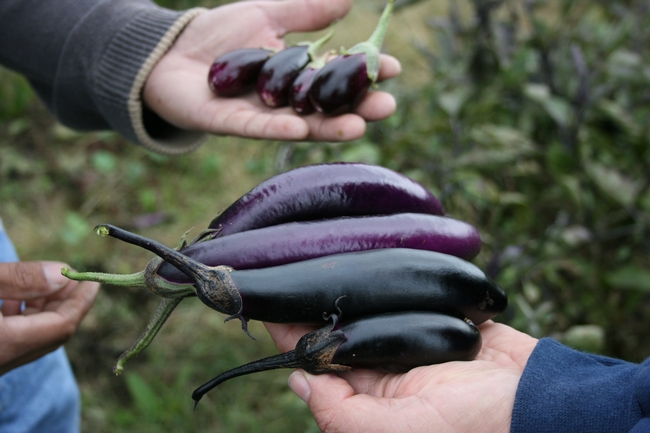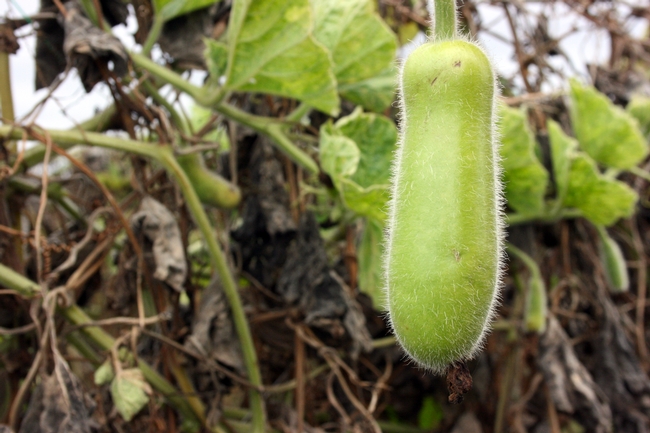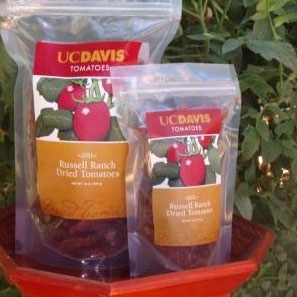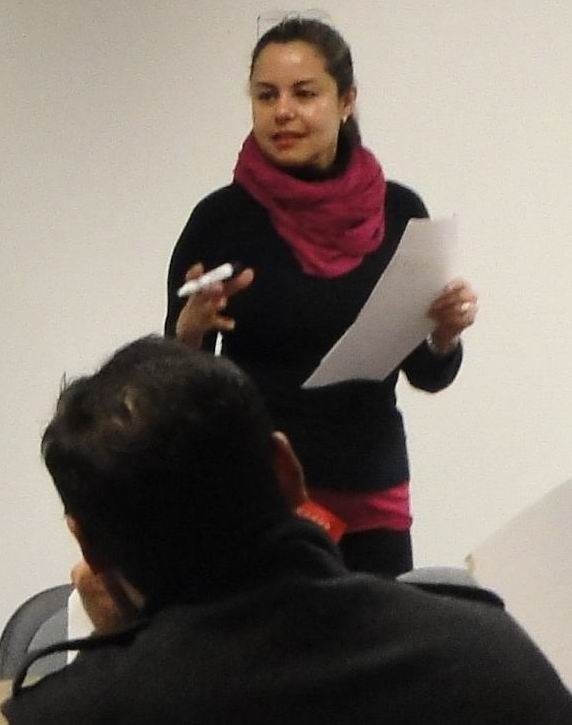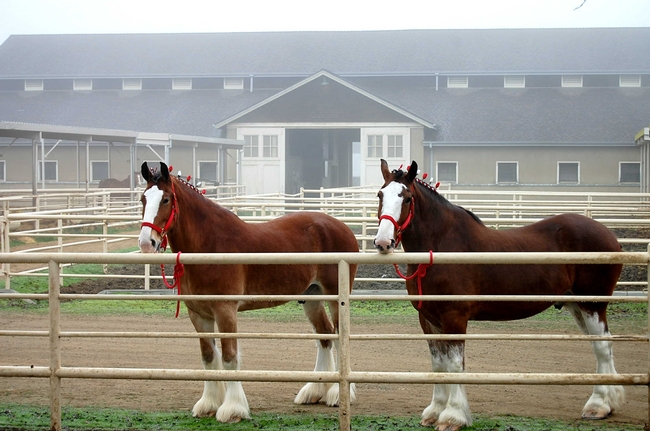UC Food Blog
When vegetables become an adventure
Walking through a field lined with row upon row of different vegetables — many ready for the picking — can be an exercise in abundance. When you're faced with the prospects of a huge, just-picked Japanese cabbage or spicy green lo bok pulled fresh from the ground, suddenly vegetables might seem like less of a chore and more of an adventure.
I had a chance recently to visit Tchieng Farms with Richard Molinar and Michael Yang, both of UC Cooperative Extension Fresno County and the Small Farm Program. This pair has been part of the Great Veggie Adventure over the last several months along with the rest of the Small Farm Program team.
We were visiting the farm to share some new "veggie adventures" that went beyond the four colorful vegetables highlighted in this project (to refresh your memory, the Great Veggie Adventure highlighted Romanesco, rainbow carrots, party cauliflower and watermelon radishes).
Molinar and Yang showed me many vegetables I had never tried, including moqua, sinqua, long beans, lo bok, opo and winter melon.
"One of the exciting things about this job is you always learn something new," Molinar said. "Our specialty is with the Asian vegetables, with Michael's expertise in that area. Asians have vegetables that are unique to their culture, that they prefer — just like Punjabis have vegetables unique to their culture, and Hispanics have vegetables common to them."
We walked between the trellised crops and up and down the plant rows, while Yang and Molinar picked samples and talked about how to eat these new-to-me vegetables.
Yang pointed out that sometimes Asian vegetables include familiar varieties that are grown and eaten in less familiar ways. For example, many Hmong and Chinese farmers grow sugar snap pea plants for the tender shoots, tendrils and leaves instead of the pea pod.
Make sure to watch our short video from that day:
Still curious?
- Find more information about growing Asian vegetables from the UC Small Farm Program
- Visit the official Great Veggie Adventure website by the makers of Hidden Valley Salad Dressings
- Watch more videos from our Great Veggie Adventure playlist
Dried tomatoes are a healthful stocking stuffer
Adding to a growing list of campus-produced products, Russell Ranch has introduced a new UC Davis product -- Russell Ranch Dried Tomatoes.
Russell Ranch Dried Tomatoes are grown at UC Davis' Russell Ranch Sustainable Agriculture Facility, a 300-acre farm west of campus. The organically grown tomatoes are part of a century-long study of agricultural sustainability at the ranch that compares the long-term effects of different ways of farming.
Research at Russell Ranch focuses on soil and water quality, nutrient cycling, pests and profitability.
“We developed this product to help meet a campus desire for more locally grown food. We also wanted to share with those on and off campus what’s happening at Russell Ranch. It is unique for a research farm of this size to be entirely dedicated to a century-long study of agricultural sustainability, and it is the only one of its kind in Mediterranean ecosystems,” said Kate Scow, director of Russell Ranch, which is a program of the Agricultural Sustainability Institute at UC Davis.
After years of selling tomatoes off campus, Russell Ranch staff began working with UC Davis Dining Services as it sought more sources of locally grown food in order to reduce the carbon footprint of food served on campus. For the past two years, freshly harvested Russell Ranch tomatoes have been used in the Russell Ranch Roasted Tomato Sauce that accompanies a variety of dishes - from pizza to polenta and ratatouille - served on campus.
This year, Russell Ranch staff developed a new limited-quantity product that can be enjoyed on and off campus.
Russell Ranch Dried Tomatoes are also available at the Memorial Union Coffeehouse, the UC Davis Medical Center and for purchase through the UC Davis Bookstore.
$4 for a 2.75 oz. bag
$12 for a 9.75 oz. bag
UC CalFresh helps low-income consumers choose healthful foods
UC’s Food Stamp Nutrition and Education Program, or FSNEP, has officially changed its name to University of California CalFresh Nutrition Education Program, or UC CalFresh for short.
In 2008 the U.S. Department of Agriculture’s Food and Nutrition Service changed the name of the food stamp program to the Supplemental Nutrition Assistance Program (SNAP). Last year, the California Department of Social Services updated to CalFresh, the name of the state program that issues monthly electronic benefits that can be used to buy food.
“Since food stamps are no longer used nationally, and the name has been changed, we have needed to change our name to conform with the USDA and CDSS changes,” said David Ginsburg, director of UC CalFresh.
The federal food assistance program, which started in 1939, was created to improve the nutritional status of low-income people.
UC CalFresh provides nutrition education to children and adults who participate in CalFresh in 33 counties. In 2011 UC Cooperative Extension provided nutrition education on topics ranging from healthy food choices to money and resource management to approximately 140,000 Californians who were eligible to receive CalFresh benefits.
In Santa Clara County, UC CalFresh staff members have worked with more than 520 families over the past year. UC Cooperative Extension nutrition advisor Susan Algert recently tested the effectiveness of a three-class UC CalFresh series focused on shopping, resource management, food safety and a healthy diet. Algert and colleague Carmen Simmons documented changes in the home food environment of five Hispanic families participating in the Eat Smart Be Active classes in Santa Clara County. Four families who were not participating in the classes were also recruited for the project as a control group. All of the children in the families were participating in UC Cooperative Extension nutrition education lessons in their schools.
Algert and Simmons found that making a shopping list, planning menus, shopping less often and using leftovers were the most effective tactics to help families save money on food. At the same time, the families increased the fruit and vegetable variety in their diets by 30 percent, increased the amount of fresh fruit by 30 to 50 percent and increased the use of whole wheat bread by 75 percent.
One participant said, “I learned very much about how to stretch my food dollar until the end of the month, something I couldn’t do before."
For more information, visit the UC CalFresh website at uccalfresh.org.
Grapefruit wonder
I have this huge grapefruit tree in my garden. It is at least 30 feet high and just as wide. It must be at least 70 years old and yields hundreds of pounds of grapefruit annually. The variety is an old standard variety called "Marsh." Marsh grapefruit were introduced in Florida in 1860 and it has been in the industry ever since. It is relatively cold hardy variety and has survived many hard freezes here in northern California. Even though our grapefruit tree gives us a lot of fruit and it has a very long harvest period (February to August), I have to say it isn’t the best tasting variety of grapefruit I have ever had. No, that honor would go to some of the more recent grapefruit introductions. There are several hybrid varieties that yield large and very sweet fruit. They are just now beginning to harvest many of these and they will be in your farmers markets and grocers soon. The trees could be in your garden too but I would wait until spring to plant since the young trees can be very susceptible to frost injury.
One of my favorite "grapefruit" varieties is one that is similar to my Marsh but sweeter and has an earlier harvest period. It is a "Cocktail" hybrid. However, it really isn’t a grapefruit at all but rather a hybrid of a mandarin and a sweet pummelo. Its juice and fruit are so sweet and delicious. It does have seeds but the flavor is amazing and truly worth planting in the garden for its wonderful juice as well as for fresh eating. It begins to ripen in January and will hang on the tree through March.
Another great variety with an even earlier harvest period is a grapefruit called "Oro Blanco." Oro Blanco is a hybrid between a white grapefruit and a sweet pummelo and was introduced in 1980. This one is also very sweet, but it is seedless and has a much earlier harvest period, from December to March. The only thing that may be a bit off putting is that it has a greenish yellow rind rather than the bright yellow gold of other varieties. Nonetheless, I find this one to be a winner in my book. In fact, in Citrus Variety Collection Notes at UC Riverside, it says:
"10/1988, EMN: My opinion, for what it might be worth, regarding Oroblanco vs Melogold, is this: For maximum returns as a cash crop, plant your acreage to Melogold; but save one space near your back door for a tree of Oroblanco for your own use."
Melogold is another hybrid and a sister variety to Oro Blanco. It was introduced to the industry in 1986 by the Citrus Research Station at UC Riverside. Melogold is fairly similar to Oro Blanco but the fruit is a bit larger and the rind is more yellow at maturity. Both are winners in my book. For more information on this and other citrus varieties for your garden, read the free online publication "Tried and True or Something New: Selected Citrus Varieties for the Home Gardener."
Now, what can you do with grapefruit besides just eat the fruit or squeeze the juice for breakfast? Well, there is always grapefruit and fennel salad, grapefruit sorbet, grapefruit glaze for fish, grapefruit and pomegranate juice martinis, and one of my favorites this time of year is a cranberry-grapefruit conserve that my mom used to make. Here is the recipe:
Mom’s Cranberry-Grapefruit Conserve
Ingredients:
- One large grapefruit (red or white)
- Water
- 2 1/2 cups sugar
- 1 pound fresh or frozen cranberries
Steps:
- Peel strips of the rind from the grapefruit. Include a small amount of white pith.
- In a medium saucepan, blanch the strips by bringing them to a boil over moderate/high heat. Drain and repeat once more.
- Dice the blanched peels into about ¼ inch pieces; reserve.
- Juice the grapefruit.
- Combine the grapefruit juice, cranberries, 1-1/2 cups of the sugar and 1-1/2 cups of water and bring to a boil. Simmer over low heat, stirring occasionally, until the liquid has reduced by half and the cranberries are cooked down, about 1-1/2 hours.
- In a medium saucepan, mix the diced blanched grapefruit peel with 1 cup of sugar and one cup of water. Bring to a boil and then simmer over moderate heat, stirring occasionally, until the peel is translucent, about 40 minutes. Add the peel and syrup to the cranberry mixture and simmer together over moderate heat, stirring occasionally, until reduced to 3 cups, about 25 minutes. Serve at room temperature or chilled. This conserve can be stored for up to a month in the refrigerator.
Note: I like to pour the slightly warmed conserve over cream cheese to spread on crackers or I also serve it with fish or turkey.
Happy Holidays
Is beer sacred? One man thinks of it that way
On a recent Sunday night I went to see Charles Bamforth, the University of California's only professor of brewing, speak at Sudwerk Riverside in Folsom, hosted by the Sacramento Chapter of the UC Davis Alumni Association. The standing-room-only banquet room had an empty seat next to a winemaker and a food scientist; a married couple who came back early from a weekend in Santa Cruz for some edutainment and local brew. Bamforth can pack ‘em in on most of his speaking venues.
Bamforth teaches in the UC Davis food science department. Brewing is fermentation science, which is a food science, and Bamforth’s book on Beer and Health is proof that beer is indeed food. He claims beer is better for health than wine — a point he loves to argue with the wine professors at the Robert Mondavi Institute of Wine and Food Science. That is where his shiny new sustainable brewery was installed by Anheuser Busch.
Bamforth’s favorite movie is, not surprisingly, “How Beer Saved the World.” You can watch it free online in 43 minutes without commercials. As he likes to point out, unlike water, almost no one gets sick from beer. “When is the last time you heard of a beer recall?” he quipped with a grin. If people are worried about illness from eating fruits or vegetables, he suggested they should wash them in beer.
Bamforth likes to share a chuckle over another bit of history. While reading the memoirs of former Chancellor Emil Mrak he learned that Mrak never got permission from the UC Regents to start the UC Davis brewing program in 1958. Maybe after the University of Wisconsin turned down the brewers association when they offered to fund the program there Mrak was wise enough not to ask permission.
As the third UC Davis brewing professor, Bamforth brought British expertise and his own comedic sensibilities. He punctuates brewing science with artful trivia on British, German and Flemish brewing traditions. It is easy to see why his general education classes on beer and brewing are the second largest on campus. (The largest is the formidable favorite, Human Sexuality, but when Playboy magazine published their higher education issue this year it was the brewing class, not sexuality, they featured.) Guest lecturers for his class include the brewing celebrities Fritz Maytag, former owner of San Francisco’s historic Anchor Steam, and Ken Grossman of Sierra Nevada Brewing.
Comedic timing aside, Bamforth also has a serious side. He handles the typical questions with ease, such as, “Why is most American beer so flavorless compared to craft brews?” (He frequently reminds us that the best selling beer is Bud Light.) He compared weather in California to England’s, and reminded us that a light beer is a thirst quencher on hot days and a better pairing for spicy Thai curry and cheesy Mexican cuisines. Bamforth says that neutral beer is more difficult to make consistently — fewer flavors to hide the defects or mask regional differences.
Bamforth’s newest book title, Beer Is Proof God Loves Us: Reaching for the Soul of Beer and Brewing, is a spoof on the Ben Franklin quote, Wine is proof God loves us. If Bamforth had his way, beer would be more revered than wine for its role in human history. He doesn’t care for silliness like beer pong or ridiculous commercials portraying drinking as one-upmanship. He teaches mindfulness and its role in responsible drinking. Drinking beer properly involves a bit of ceremony as meaningful as pouring tea. He instructs us that beer should always be poured into a perfectly clean glass, one that has not had any fingers inside on its trip to the table. There should be a foam head after the perfect pour. Maybe a whispered “Thank you, God” before the first sip would make a nice addition to the ceremony as well.
For more information:
- Courses in food science
- Interviews with Bamforth on Public Radio
- How Beer Saved the World
- UC Davis Brewing and Food Science Laboratory and Winery
- Sudwerk Riverside in Folsom


